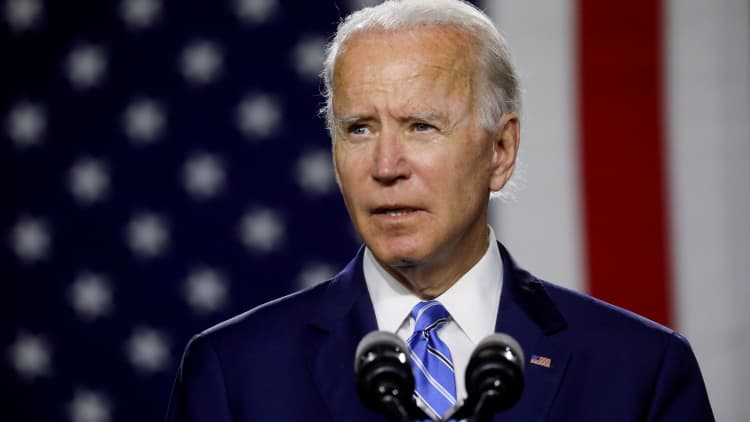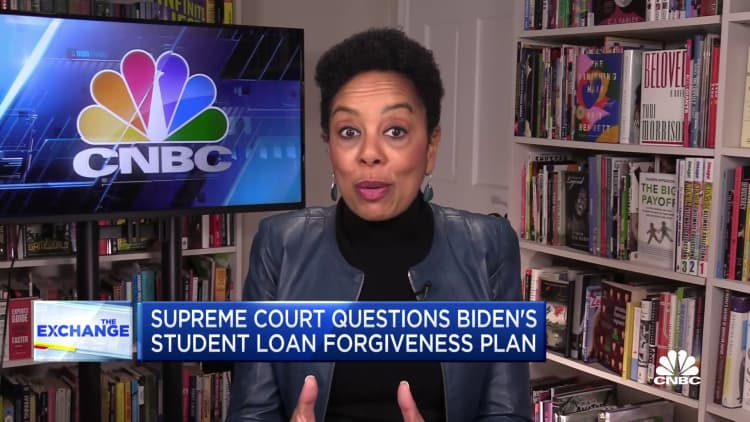[ad_1]
A protest sign outside the Supreme Court in Washington, D.C., on Feb. 28, 2023.
The Washington Post | The Washington Post | Getty Images
There’s no precedent in recent history for the sweeping federal student loan forgiveness policy President Joe Biden is trying to carry out.
A look at the math of the program shows how deep the relief could be for borrowers, many of whom were struggling before the Covid pandemic — when the economy was in one of its healthiest periods.
Since then, federal student loan payments have been on hold for three years. Biden had hoped to cancel up to $20,000 in debt for tens of millions of Americans before resuming the bills, but his policy soon faced a barrage of legal challenges, and its fate now rests with the Supreme Court.
More from Personal Finance:
Is Supreme Court Justice Barrett key to student debt relief?
What to do if Biden’s student debt plan is struck down
Here’s how things go so bad with student loan debt in the U.S.
The outcome of the justices’ decision could have dire consequences on families, said Thomas Gokey, co-founder of the Debt Collective, a national union of debtors.
“For many people, this is life and death,” Gokey said. “What’s at stake is being forced to choose between paying for student loans or being able to buy groceries, make rent and pay medical bills.”
Here’s what’s on the line, by the numbers.
$400 billion in student debt gone

If every eligible borrower applies for the relief, Biden’s student loan forgiveness plan is estimated to wipe out $400 billion in federal student debt, according to the Congressional Budget Office.
That would reduce the country’s $1.7 trillion outstanding education debt balance to $1.3 trillion.
14 million borrowers given a fresh start
Roughly a third of those with federal student loans, or 14 million people, would have their balances entirely forgiven by the president’s program, according to an estimate by higher education expert Mark Kantrowitz.
These borrowers likely won’t have to make a student loan payment again, Kantrowitz said. The Biden administration has said it won’t resume the bills until 60 days after the litigation over its plan resolves (or at the end of August if the challenges are still pending).
For many people, this is life and death.
Thomas Gokey
co-founder of the Debt Collective
“Sixty days will be enough to forgive student loan debt if the president’s plan survives,” Kantrowitz said. “They’ve already approved forgiveness for 16 million borrowers, so they just need to transmit this information to the loan servicers.
“It should take one to two weeks for the servicers to implement,” he added.
37 million people get some loan forgiveness
Biden’s relief is limited to borrowers who make under $125,000 a year as individuals or less than $250,000 as a couple.
Still, that means around 37 million people would be eligible for loan cancellation, Kantrowitz estimates — up to $20,000 if they received a Pell Grant in college, a type of aid for low-income families, or as much as $10,000 if they did not.
Monthly bills cut by a third or more

The U.S. Department of Education has said it plans to “re-amortize” borrowers’ new balances after forgiveness. That’s a wonky term that means it will recalculate people’s monthly payment based on their lower tab and the number of months they have left on their repayment timeline.
Kantrowitz provided an example: Let’s say a person currently owes $30,000 in student loans at a 5% interest rate. Before the pandemic, they would have paid around $320 a month on a 10-year repayment term.
If forgiveness goes through, and that person get $10,000 in relief, their total balance would be reduced by a third, and their monthly payment will drop by a third, to roughly $210 a month.
[ad_2]
Source link
